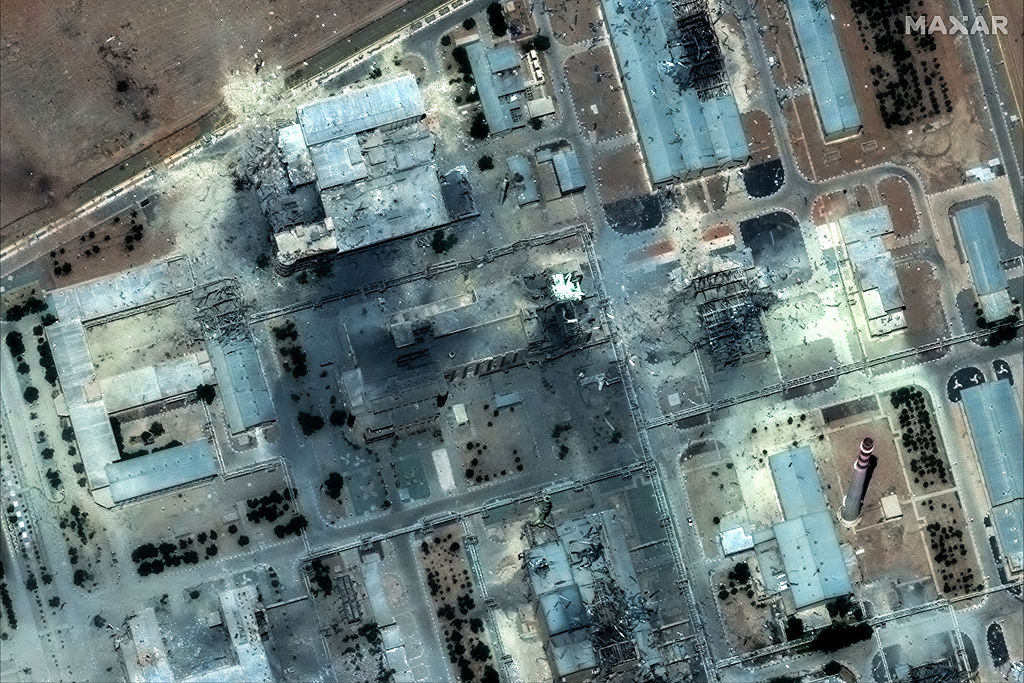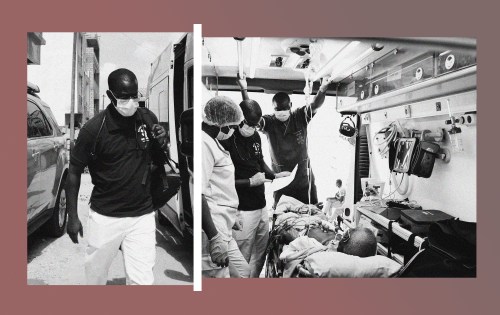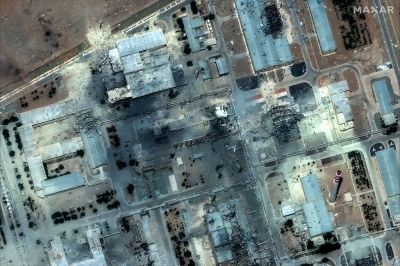Happy Monday! We’re hosting our next Dispatch Premium Town Hall this Wednesday, July 2, at 8 p.m. ET on Zoom. This time around, Steve Hayes and Jonah Goldberg will preview our newest initiative: The Next 250, a year-long discussion of America’s founding principles leading up to the nation’s semiquincentennial.
Remember, these interactive virtual events are reserved for premium members. To join, make sure to upgrade your membership by Wednesday.
Quick Hits: Today’s Top Stories
- Senior Iranian officials, in a private call intercepted by the U.S., said that American airstrikes targeting three Iranian nuclear sites were not as devastating as initially expected, the Washington Post reported on Sunday. White House press secretary Karoline Leavitt responded by claiming the intercepted communications were taken “out of context,” adding that “the notion that unnamed Iranian officials know what happened under hundreds of feet of rubble is nonsense” and that “their nuclear weapons program is over.” Though President Donald Trump previously said Iran’s three major nuclear facilities were “completely and fully obliterated,” an initial assessment by the Defense Department’s Defense Intelligence Agency reportedly indicated the U.S. airstrikes only set back Iran’s nuclear program a few months, a conclusion the White House said was “flat-out wrong.”
- Russia launched a large-scale aerial assault across Ukraine early Sunday morning, killing at least four people in what a spokesman for the Ukrainian Air Force described as “the most massive airstrike” of the all-out war that began with Russia’s February 2022 invasion. The spokesman added that Russia launched a total of 537 aerial weapons into seven different Ukrainian regions, including 477 drones and 60 missiles. Ukrainian President Volodymyr Zelensky said that Russian forces “were targeting everything that sustains life,” adding that a Ukrainian F-16 fighter pilot crashed and died while defending against the attack. Russia’s air assault also spurred Poland to scramble jets and prepare its air defenses due to some of the barrage’s proximity to the country’s border with Ukraine.
- The Israel Defense Forces (IDF) issued evacuation warnings to Palestinian residents in parts of northern Gaza on Sunday, citing intensified military operations to “destroy the capabilities” of terrorist groups, including Hamas. Earlier that day, a 20-year-old IDF soldier was killed by an explosive device while operating in the northern Gaza Strip, according to an initial military probe. On Saturday, the IDF said its forces killed a co-founder of Hamas’ military wing, Hakham Muhammad Issa Al-Issa, who helped train and ready forces for the group’s October 7, 2023, attack on Israel. Meanwhile, Trump continued over the weekend to urge Israel and Hamas to agree to a ceasefire and hostage release deal.
- The Supreme Court ruled on Friday that district judges do not have the authority to issue nationwide injunctions, partially reversing three separate district court rulings that temporarily blocked Trump’s January 20 executive order ending birthright citizenship. The justices did not rule on whether Trump’s order—which contended that the 14th Amendment has been misinterpreted “to extend citizenship universally to everyone born” in U.S. territory—was constitutional. Rather, in a 6-3 decision, the justices ruled that district courts could temporarily block executive actions from being enforced against specific plaintiffs in a case—such as the individuals suing Trump over his birthright citizenship order—but have no authority to issue injunctions that temporarily bar the executive action from taking effect across the country. “When a court concludes that the Executive Branch has acted unlawfully,” Justice Amy Coney Barrett, who authored the majority opinion, wrote, “the answer is not for the court to exceed its power, too.”
- The Senate voted 51-49 late on Saturday night to advance the Trump-endorsed budget reconciliation bill, officially called the “One Big Beautiful Bill Act.” Senators voted mostly along party lines, with the exceptions of GOP Sens. Rand Paul of Kentucky and Thom Tillis of North Carolina, who joined Democrats in opposing the motion to proceed. The nonpartisan Congressional Budget Office released an analysis on Friday projecting the bill would add $3.3 trillion to federal budget deficits over the next 10 years. On Sunday, the Senate parliamentarian informed senators that several provisions of the bill violate the Byrd Rule’s stipulations for what can be passed via budget reconciliation, which allows the bill to be passed with a simple majority. Further specific policy details are expected to be tweaked before a final vote on the bill is brought to the chamber floor. Trump has made it clear he wants the Senate to pass the bill before July 4.
- Meanwhile, Tillis—one of the two GOP senators to vote against advancing the reconciliation bill, citing funding cuts to Medicaid that he said “would be devastating to North Carolina”—announced Sunday that he would not seek reelection in the 2026 midterm elections, and instead retire at the end of his second six-year term. “In Washington over the last few years, it’s become increasingly evident that leaders who are willing to embrace bipartisanship, compromise, and demonstrate independent thinking are becoming an endangered species,” Tillis said in a statement. The news came one day after Trump said on social media he would meet with potential GOP primary challengers to Tillis to find someone who can “properly represent” North Carolina. Reacting to Tillis’ decision not to seek re-election, Trump responded, “Great News!”
A message from Incogni
Your Personal Info Is Out There — Incogni Helps Wipe It Clean
Your home address, phone number, even your Social Security number—all are searchable online and often sold to marketers or exposed to scammers. Incogni automatically tracks down and removes your personal data from over 270 data broker sites. For even greater control, the Unlimited Plan lets you target any other sites you choose. Stay private, stay protected.
Intel Leaks and Unanswered Questions

When it comes to this month’s strikes on Iran, “obliterated” is the White House’s word du jour. After B-2 bombers dropped 30,000-pound “bunker buster” munitions on Iran’s nuclear facilities earlier this month, President Donald Trump has been consistently emphatic that the country’s nuclear program was completely destroyed in what amounts to a massive victory for his administration—if it’s accurate.
“Tonight, I can report to the world that the strikes were a spectacular military success,” Trump said hours after the operation. “Iran’s key nuclear enrichment facilities have been completely and totally obliterated.”
But in the days since the attack, the picture has grown murkier. A leaked preliminary assessment from the Defense Intelligence Agency (DIA)—one that the White House insists is “flat out wrong”—stated that Iran’s nuclear program may have only been set back “months.” Since then, Israeli intelligence, the CIA, United Nations watchdogs, and others have weighed in with varying analyses—some very optimistic, some less so. American intelligence agencies are unlikely to have a more precise estimate of the damage for weeks—and in the meantime, the Trump administration will have to grapple with the implications of intelligence leaks conflicting with the White House’s official narrative.
Despite several sources announcing initial intelligence about the attack, the leaked DIA report has attracted the most attention. The assessment reportedly found that the explosions from the strike only sealed off the entrances to two of the facilities rather than destroying their underground complexes, delaying Iran’s nuclear program by less than six months. It also asserted that much of Iran’s enriched uranium was moved from the sites ahead of the strikes, which would indicate that Iran is still in possession of large amounts of uranium that could be enriched to create a nuclear weapon.
However, the report is a “low confidence” preliminary assessment based on only 24 hours of intelligence gathering, relying on satellite imagery and signals intelligence rather than an on-the-ground assessment.
“It sounds like DIA was responsible and said ‘this is preliminary, and, therefore, right now, we give it a low confidence level because we don’t have a lot of pieces of information,’” Larry Pfeiffer, a former chief of staff at the CIA and former senior director of the White House Situation Room, told TMD. But low confidence is not the same as no confidence, and further intelligence gathering will determine whether the initial assessment is correct.
The preliminary DIA report is only one intelligence set among many. A day after the leak, CIA director John Ratcliffe said in a statement that a “body of credible intelligence” indicated that Iran’s nuclear program had been “severely damaged” and “would have to be rebuilt over the course of years.”
“To get something like that cleared and released is significant,” Gabriel Noronha, president of POLARIS National Security and former special advisor for the Iran Action Group at the State Department, said of Ratcliffe’s statement. But the statement did not say it was an official assessment from the CIA. “It’s not comprehensive,” Noronha told TMD. “I think actually the Israeli assessment is more telling.”
Israeli intelligence services are optimistic about the damage done to Iran’s nuclear program. Officials in Israel are reportedly very satisfied with the operation, and a military spokesman said last week that, although it was too early to say for sure, Tehran’s nuclear program was likely set back years. “The Israelis have no reason to hold back,” Noronha said. “They would have every interest, if they assessed that there was more to be taken out, [to] say, ‘No, more needs to be taken out.’”
The Institute for Science and International Security—a nonpartisan organization that tracks Iran’s nuclear activities—found that the country’s centrifuge enrichment program was “effectively destroyed,” estimating that the time it would take for Iran to make a functional nuclear weapon has increased significantly. But it assessed that stocks of enriched uranium still exist, and some centrifuges that were manufactured but not yet installed at Natanz and Fordow were not destroyed.
Rafael Grossi, the director general of the International Atomic Energy Agency (IAEA)—the U.N.’s nuclear watchdog—offered a measured assessment last week. He said that there was “severe damage” but not “total damage” to the nuclear program, potentially allowing Tehran to restart uranium enrichment in a matter of months. But Grossi also noted that the centrifuges used to enrich uranium at Fordow are “no longer operational” based on the types of munitions used in the U.S. attack and the delicacy of the machinery.
Overall, drawing conclusions from early intelligence is likely a fool’s errand. “I like to not think of these as conflicting reports or contradictory reports,” Pfeiffer said. “I like to think of these as reports that are all contributing to what will ultimately be our understanding of what happened. It’s not unusual for there to be differences in reporting, particularly early on, because nobody really knows exactly what happened. … It’s incumbent on the intel community to provide assessments as soon as they start to get them.”
The various intelligence agencies are often working with different sources of information. The initial report from DIA relied primarily on signal intelligence and satellite imagery, while Pfeiffer noted that the CIA “probably” has some human sources contributing to its reports: “Maybe in the Iranian government, maybe in the Iranian nuclear program.”
Various agencies will continue to collect data, painting a clearer picture of the actual damage done to Iran’s nuclear program, but the information environment is complex—particularly at this early stage. According to Washington Post reporting over the weekend, the U.S. intercepted a call in which Iranian officials discussed the damage to their nuclear program being less than expected. However, Axios reported Sunday that Israeli officials believe the Iranian military has been giving false reports to the country’s political leaders, while the extent of the damage remains largely unknown. The Trump administration also cast doubt on the accuracy of the intercepted communications. “The notion that unnamed Iranian officials know what happened under hundreds of feet of rubble is nonsense,” White House press secretary Karoline Leavitt said. “Their nuclear weapons program is over.”
From a political perspective, however, Trump has a strong incentive to frame the strike as a success, which may complicate the reporting of intelligence around the damage. In particular, Trump has trained his fire on the DIA damage assessment. The FBI has launched an investigation into the leak, but as of the time of publication, it remains unclear who sent the report to the media outlets. That hasn’t stopped Trump from accusing “The Democrats” of orchestrating the leak, writing on Truth Social that “they should be prosecuted!”
As of now, there is no public evidence indicating that the DIA leak emanated from Congress, but the Trump administration reportedly decided last week to limit the intelligence it shares with lawmakers on Capitol Hill. The move concerned Pfeiffer. “Congress has an important oversight role to play,” he told TMD. “Restricting information from Congress should not be the first and most immediate thing you consider doing when you’re doing a leak investigation unless you honestly have some solid information that it was coming from Congress.”
After delays, the White House eventually provided a classified briefing to Congress on the Iran attacks on Thursday. Going forward, though, the administration will limit what it posts to CAPNET, the system it uses to share classified information with Congress. “Historically, when we’ve ever tried to hold things back from Congress, it usually backfires in a pretty big way against the intel community,” Pfeiffer said. “Once you start restricting the information flow, you run the risk of people making decisions without all the information they need to make the decisions.”
And based on past incidents, Congress is not the most likely culprit. “From my experience, [the Department of Defense] is the big leaker,” Noronha said. “Congress rarely leaks.” He agreed with the administration that the motivation for leaking the preliminary assessment was likely to score political points against Trump, but as former intelligence official Klon Kitchen wrote for The Dispatch on Friday, such leaks cause other issues as well.
The intelligence community operates under rigorous standards because policymakers need honest assessments, even when those assessments are incomplete or unwelcome. When analysts provide preliminary [battle damage assessments] with appropriate confidence caveats, they’re fulfilling their obligation to give decision-makers the best information available at the time, while acknowledging analytical limitations.
Leaks disrupt the delicate balance between providing timely intelligence and maintaining operational security, and policymakers are rightly frustrated when sensitive assessments appear in the media before policy decisions can be made.
Whatever motivated the leak of preliminary battle damage assessments, the effect is counterproductive. When “low confidence” initial assessments appear publicly without context, they’re misconstrued as intelligence failures rather than analytical works in progress.
The initial damage assessments still leave many questions unanswered. One significant missing piece of information is whether Iran moved its enriched uranium from its nuclear facilities before the strikes. Defense Secretary Pete Hegseth has said that he did not know of anything being moved from Fordow, but he did not address other facilities. In an interview with ABC News last Sunday, Vice President J.D. Vance implied that Tehran still has enriched uranium, an issue that would be addressed in future negotiations over the fate of the nuclear program.
If Iran retained large stockpiles of enriched uranium, it would make restarting the country’s nuclear program easier, according to Pfeiffer, although Iran would still have to rebuild its centrifuges, scientific leadership, and weaponization program. Israel has assessed that its 12-day military campaign in Iran killed at least 14 of the country’s top nuclear scientists.
As intelligence agencies collect data, it may be some time before a clear picture emerges about how far the nuclear program has been set back overall. “We’re never going to 100 percent know where they maybe hid stuff beforehand,” Pfeiffer said. “Do they have secret alternate locations that duplicate some of the work they were already doing? Those are some of the things that we’re going to press upon our intelligence community and our diplomatic services to go and try to find out as we move forward.”
Whatever the extent of the damage, the attacks have demonstrated that Israel and the U.S. can operate in Iranian airspace with impunity, leaving open the possibility of future airstrikes and giving Washington more leverage in any future negotiations aimed at reaching a deal. But if Iran begins to move forward with trying to rebuild its nuclear program, it might take some time for the U.S. to even find out.
“It could take a year or more to really determine. And that’s ultimately kind of the scary thing,” Pfeiffer said. “What are Iran’s intentions going forward?”
A message from Incogni
Is Your Personal Data Fully Protected?
If that question gave you pause for even a second, the answer is no.
In today’s world, so much of our personal information is online. And while there are plenty of data brokers who use it for legitimate reasons, there are just as many bad actors looking to access your sensitive information—things like your Social Security number, birthdate, and phone number—for their own malicious purposes. Not good.
But before you slap your phone in frustration from another potential scam call … you need to try Incogni. Incogni scrubs your personal data from the web, removing sensitive data from “people search sites” and thousands of other websites that expose your private details. It’s your one-stop solution for personal data protection.
Today’s Must-Read
President Trump prefers peace deals to the use of military force, and he reportedly delayed Israel’s plans to attack Iran earlier this spring and destroy—or at least degrade—the country’s nuclear and missile capabilities. But after the first few days of Israel’s highly successful air, intelligence, and cyber offensive in mid-June, Trump did not urge de-escalation. “[Iran] had bad intentions,” he told reporters. “For 40 years they’ve been saying death to America, death to Israel, death to anybody else they didn’t like. They were schoolyard bullies. And now they’re not bullies anymore.” Trump’s comment reflected his belief that, since the Jimmy Carter administration, U.S. Iran policy produced disappointing results because decision-makers failed to understand the ideology that drives and constrains Iran’s theocratic dictatorship.
Toeing the Company Line
How Mission Hospitals Are Combating Africa’s Medical ‘Brain Drain’
Plus: Quick questions with Ryan Burge.
Getting It Wrong in New York City and Elsewhere
Why Zohran Mamdani is way off and proceduralism has never worked.
Failure Is Not an Option
The war over the success of the Iran war.
MAGA Voters Happy With Trump’s Iran Strike, Insiders Say
The president’s base is also divided on Israel along generational lines.
Supreme Court Sides With Trump Administration on Nationwide Injunctions in Birthright Citizenship Case
The Supreme Court heard arguments in the dispute on May 15.
Why MAGA Loves the 1950s
Republicans are focusing on one decade as the epitome of the good life.
It’s Time to Prosecute Pornhub
Long-dormant obscenity laws should get a new look in the age of pervasive and extreme porn.
The Many Redemptions of Wes Anderson
The avant-garde filmmaker is actually quite conservative.
Assessing Trump’s Claims That He Was ‘Very Much Opposed’ to the Iraq War
He did not criticize U.S. military action in Iraq until after the invasion in March 2003.
Zohran Zealots
The axis of things that make Jonah mad.
SCOTUS Sides with Trump
Birthright citizenship’s climactic non-decision.
Worth Your Time
- As U.S. intelligence officials continue to assess how much damage the U.S. airstrikes wrought on Iran’s nuclear facilities, Eliot A. Cohen detailed in The Atlantic what we know about battle damage assessments. “From 1991 to 1993 I ran the U.S. Air Force’s study of the first Gulf War. In doing so I learned that [battle damage assessment] rests on three considerations: the munition used, including its accuracy; the aircraft delivering it; and the type of damage or effect created,” he wrote. “To the present moment: BDA takes a long time, so the leaked DIA memo of June 24 was based on preliminary and incomplete data. … Results may be quicker now, but all kinds of information need to be integrated—imagery analysis, intercepted communications, measurement and signature intelligence (e.g., subsidence of earth above a collapsed structure), and of course human intelligence, among others. … The DIA report was, from a practical point of view, worthless. An educated guess, however, would suggest that in fact the U.S. military’s judgment that the Iranian nuclear problem had suffered severe damage was correct.”
- Self-described socialist Zohran Mamdani won the New York City Democratic mayoral primary, pledging to open city-run grocery stores if elected. But as Joe Lancaster recalled in Reason, it’s far from a novel idea. “In a campaign video, [Mamdani] called the stores a ‘public option’ like in health care; he said they would not pay rent or property taxes, they would ‘operate without a profit motive,’” Lancaster wrote. “Some have come to Mamdani’s defense, saying city-owned grocery stores are not as radical as they sound—in fact, some states already have them, without becoming socialist hellscapes.” Still, they have fared poorly, Lancaster observed. “Baldwin, Florida, opened a fully government-owned grocery store in 2019 after the town’s only grocer closed the previous year. … ‘We’re not trying to make a profit,’ Mayor Sean Lynch, a Republican, told the Washington Post when Baldwin Market opened. ‘We're trying to cover our expenses, and keep the store running.’ The store closed in 2024 after being in business for less than five years. ‘The town-run store,’ the Florida Times-Union wrote at the time, ‘has struggled for years … to reach the break-even point.’”
Presented Without Comment
Axios: Trump Says Mamdani Must ‘Behave’ if Elected NYC Mayor or Face Funding Cuts
Also Presented Without Comment
Supreme Court Justice Amy Coney Barrett, addressing Justice Ketanji Brown Jackson’s dissent in Trump v. CASA, Inc.:
We will not dwell on JUSTICE JACKSON’s argument, which is at odds with more than two centuries’ worth of precedent, not to mention the Constitution itself. We observe only this: JUSTICE JACKSON decries an imperial Executive while embracing an imperial Judiciary.
Also Also Presented Without Comment
The Athletic: Yankees’ George Costanza Desk Nap Bobblehead Pre-Selling for Five Times More Than Tickets to Game
In the Zeitgeist
Longtime Pittsburgh Pirates slugger and two-time World Series champion Dave Parker, nicknamed “The Cobra,” died Saturday at the age of 74. His natural talent was trumped only by his determination on the field: After breaking his cheekbone in a collision with another player, Parker donned a hockey goalie mask for several games, allowing him to play while recovering from his injury.
Parker was elected to the Baseball Hall of Fame in late 2024 and will be posthumously inducted in July.
Let Us Know
How do you personally weigh varying intelligence assessments when it comes to something like the strikes on Iran?
A final message from Incogni
Want to Bust Spam Calls? Here’s How.
Spam calls are getting crazy lately, with some people getting 30+ calls a day from random numbers. But where does it all stem from? Simple: Your number being listed online. If you want to stop the spam, you need to scrub your personal info—and for that, there’s no better choice than Incogni. Incogni removes your personal data from the web with ease, even tackling tricky obstacles like “people search sites” and thousands of other websites. They do the hard work so you don’t have to, meaning spam calls will soon be a thing of the past. Try Incogni here and get 50% off your subscription.






















Please note that we at The Dispatch hold ourselves, our work, and our commenters to a higher standard than other places on the internet. We welcome comments that foster genuine debate or discussion—including comments critical of us or our work—but responses that include ad hominem attacks on fellow Dispatch members or are intended to stoke fear and anger may be moderated.
With your membership, you only have the ability to comment on The Morning Dispatch articles. Consider upgrading to join the conversation everywhere.